Coronavirus (COVID-19): framework for decision making - assessing the four harms
Sets out the four harms process for assessment used to establish when coronavirus restrictions could be safely lifted after lockdown and the scientific evidence underpinning the decisions.
Harm 4
Introduction
The economy is central to our wellbeing in Scotland, whether it is through the provision of direct services and goods, provision of taxes to fund public services like health and welfare, or by providing direct opportunities for employment and income.
Our business base is diverse and there are many individuals and households across Scotland that form part of it and they are providing goods and services for local communities, as well as to international markets. The impact of COVID-19 has materially changed how we interact with the economy daily and will reset many of these key interactions going forward.
The latest evidence continues to show the scale of the economic shock that Scotland, like other countries, has experienced as a result of the Coronavirus pandemic.
Output, Turnover and Business Activity
Scottish GDP fell 19.4% in quarter 2 2020 (UK: - 19.8%) – its biggest fall in quarterly GDP on record and it followed a 3.2% contraction in quarter 1 2020. The contraction over this period was similar to the UK as a whole. The size of this contraction is not surprising given that large parts of the economy were required to close during lockdown in order to protect lives.
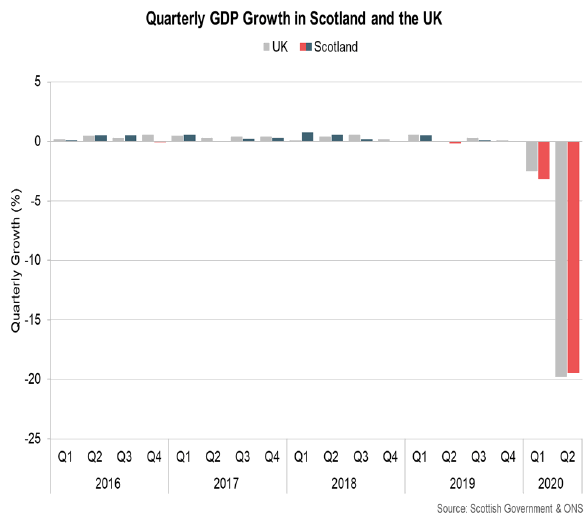
Monthly GDP figures show the pattern of economic activity following lockdown and partial reopening of the economy. Again, the pattern of change in monthly GDP is similar between Scotland and the UK as a whole. Despite growth in output in the months May to September, Scotland's GDP remained 7.6% below its pre-COVID-19 level in February (UK: 8.2%).
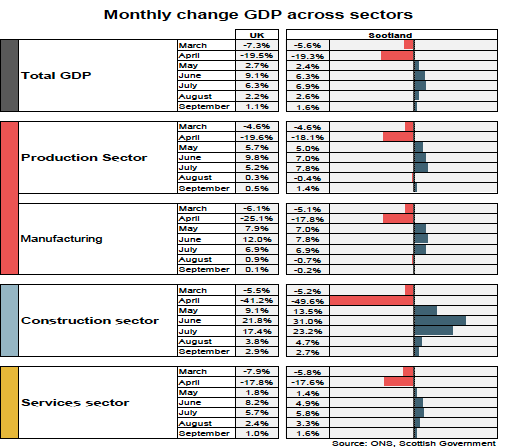
Following large contractions in March to June, business activity in Scotland stabilised and bounced back between July and September, albeit there are signs that the pace of recovery has slowed from August and into September amid continued heightened uncertainty, subdued demand and the introduction of local restrictions.
The Monthly Business Turnover Index for Scotland for September indicates that business turnover has continued to strengthen for the fifth month in a row, but remains significantly below pre-pandemic levels. Some sectors of the economy, such as the more consumer-facing sectors, have been particularly hard hit.
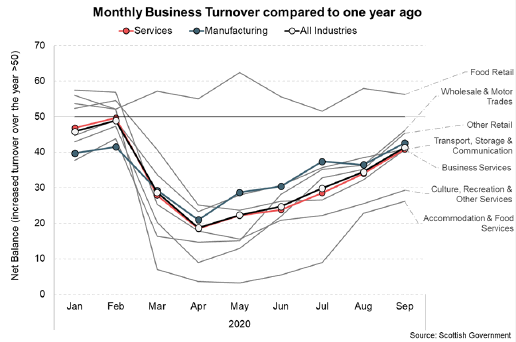
This is reflected in the differences in the proportion of businesses trading by sector. While there are 95% of business trading overall, as at the middle of November, the Accommodation and Food Services has 77% trading and the Arts, Entertainment and Recreation sector has 93% trading. These sectors have therefore been disproportionately affected, with higher proportions of businesses still closed/operating below capacity.
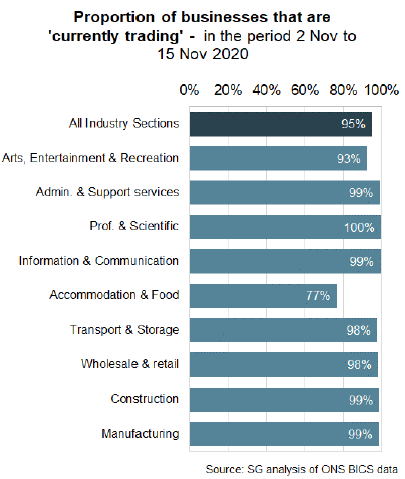
The latest business activity survey (Purchasing Managers' Index) reported that Scottish private sector business activity contracted sharply in October for the first time since July 2020 and as new restrictions on economic activity were introduced. The contraction in business activity in October suggests that there is a risk of a further contraction in economic output in the final quarter of 2020.
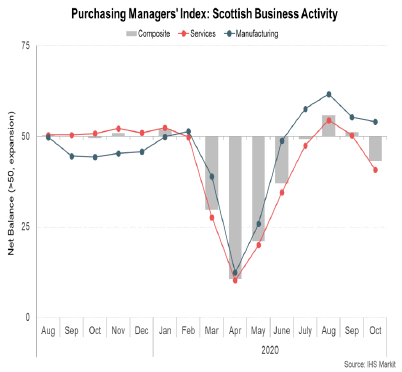
Retail Sales
Scottish Retail Consortium data on retail sales for September reported an annual decrease of 6% in total retail sales in Scotland, improving slightly from the 7.5% annual fall in August and further strengthening from the record fall in April (40.3%). Food sales increased by 3.7%, while non-food sales fell 14.2%. The combination of restrictions, pressure on incomes, subdued sentiment and heightened uncertainty continue to impact consumer activity.
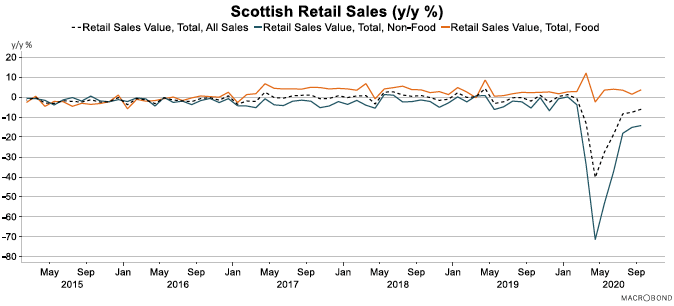
Labour Market
The impact of the pandemic on Scotland's labour market is also continuing to emerge and is likely to worsen over the coming months. The most recent labour market figures for the period until July to September 2020 show:
- Unemployment rate remaining at 4.5% and Scotland's employment rate rose by 0.4 percentage points over the quarter to 74.0%;
- At the end of August, the Coronavirus Job Retention Scheme was supporting around 10% of employees in Scotland;
- HMRC experimental early release data for October 2020 show 71,000 fewer people were in pay-rolled employment compared with March 2020 and for employees still working, the average hours worked per week (in the 3-months to July-Sept 2020) was 27.6 hours, down 11.7% (3.7 hours) from the same period one year ago;
- New job opportunities are depressed across almost all sectors with vacancies at 62.2% of their 2019 average, (ONS Adzuna data, 6 November); and
- Scotland's Claimant Count in October (Jobseeker's Allowance and claimants of Universal Credit who were claiming principally for the reason of being unemployed) is 93% higher than in March and has been over 200,000 for each of the 6 months to September) (Figure 37);
- We are likely to see some rises in inequality with young people shown to be particularly impacted so far with potentially long lasting scarring effects (greater falls in employment for young people than any other age group, ONS Labour Force Survey).
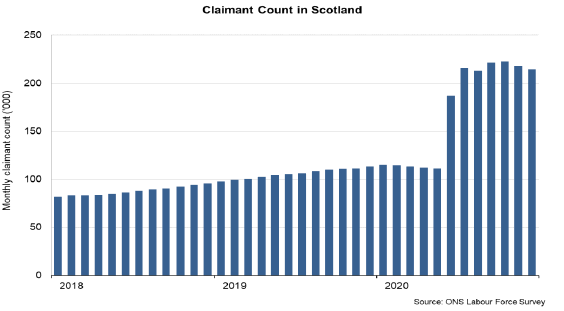
Note: Refers to Jobseeker's Allowance and claimants of Universal Credit who were claiming principally for the reason of being unemployed
The support schemes that have been put in place have protected jobs and the income of the self-employed. The latest (provisional) furlough scheme data for Scotland shows that at the end of September 2020, 183,200 employments in Scotland were on furlough under the Coronavirus Job Retention Scheme. Of those employments furloughed, 108,000 were on full furlough and 75,100 on partial furlough. The number of employments furloughed continued to decrease during September. The take up rate of employments furloughed varied across Scotland ranging from 5% to 9%. Aberdeen City, City of Edinburgh and Glasgow City had the highest take-up rates (9%).
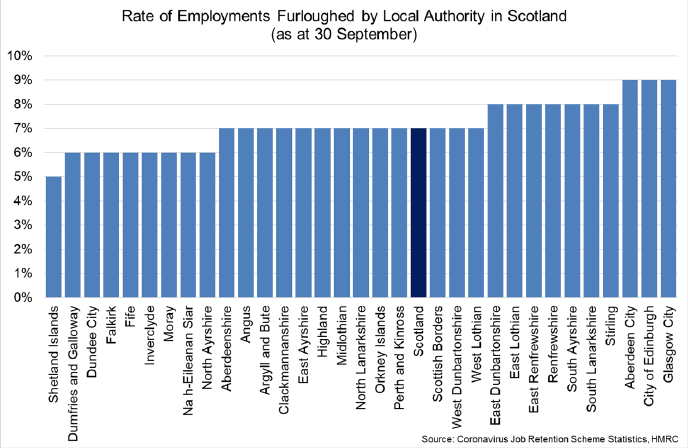
HMRC data show that by end of October, 142,000 claims in Scotland had been made to the second Self Employment Income Support Scheme (SEISS). This represents 67% of eligible population, with an average claim of £2,500. By local authority the take-up rate was highest for West Dunbartonshire (75%), Glasgow City and North Lanarkshire (74%), Falkirk, Midlothian, Renfrewshire and South Lanarkshire (73%).
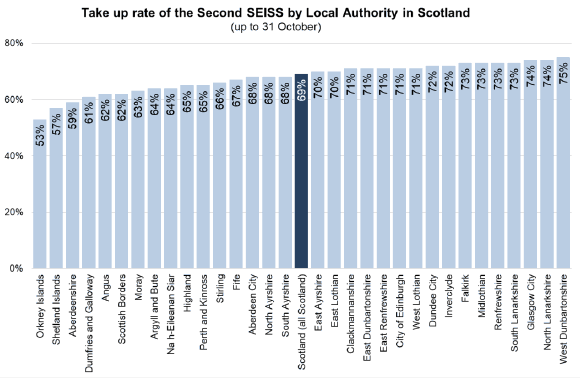
For the second SEISS individuals were able to claim a taxable grant worth 70% of their average monthly trading profits, paid out in a single instalment covering three months' worth of profits, and capped at £6,570 in total.
Business Resilience
In mid-November, the Scottish estimates of ONS Business Impact of Coronavirus Survey (BICS) data reported that 95% of businesses with a presence in Scotland were currently trading. This has increased substantially since June after falling back in September.
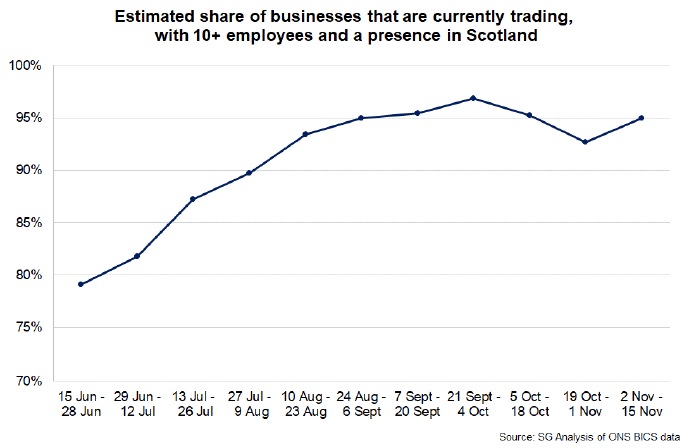
Business resilience is weakening and survey evidence suggests that many of these businesses have very weak cashflow and are facing the risk of insolvency. In the first half of November, 27% of businesses reported they had no, or less than three months, cash reserves. This overall proportion has remained within the range of 26% - 34% since June. However, the rate varies by industry sector, with highest rates for Construction (41%) and Accommodation & Food Services (41%).
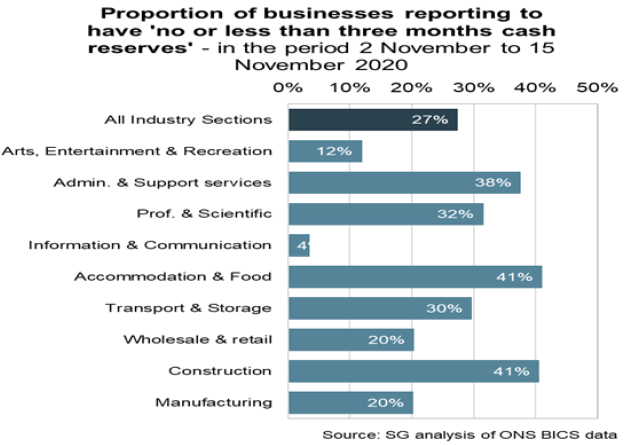
In the first half of October, 15% of businesses reported their risk of insolvency was moderate or severe. The Accommodation & Food Services industry was the sector with the highest share of businesses reporting their risk of insolvency was moderate or severe (36.0%).
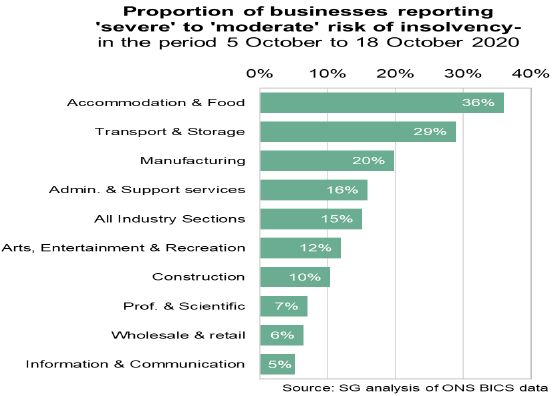
Conclusions
The dimensions of economic harm include the direct impact on the economy and are inter-related to health and social harms through the indirect effects that a weaker economy can have on health and society through, for example, the impact of unemployment. The scarring in terms of social and health effects will come via the longer recovery period, as we deal with the impacts of higher unemployment and financial insecurity and hardship for many businesses, individuals and households. The damaging effect on poverty and inequality may be profound.
There will also be gender and age-related dimensions of economic harms that are important to consider as different groups in society will be impacted in different ways depending, for example, on their labour force participation and on where they live.
As the initial lockdown has been eased, and as business and society have reopened, we have seen a reversal of the output contraction for many parts of the domestic economy. However, not all sectors have come back immediately - or to the same extent - as external demand, consumer demand and business models have changed significantly.
The ongoing (and potentially additional) restrictions to suppress COVID-19 will further weaken business resilience, although the overall economic impact of the restrictions is unlikely to be as severe as the initial lockdown. However, the longer restrictions continue, the less resilient businesses will become.
If sectors of the economy are placed under restrictions which result in them shutting down for a second time, the negative impacts may be amplified. The economic recovery is already fragile and a further sustained period of closure will lead to a greater degree of structural damage to the economy from which it may take years to recover, with long term scarring in terms of unemployment and the associated negative impacts on health and wellbeing. Many households and businesses will be extremely vulnerable to the impacts of a further lockdown.
The recovery, at present, is K shaped and the sectors that were impacted more in the initial lockdown continue to struggle for viability and may be less resilient if subject to a second sustained period of closure. Many of these are high employment sectors and, even with full furlough available for this period, we risk higher unemployment due to weak business viability. We also risk high rates of business failure in these sectors and this means that, over the longer term, we will lose some of our productive capacity for recovery.
Contact
Email: covidexitstrategy@gov.scot
There is a problem
Thanks for your feedback